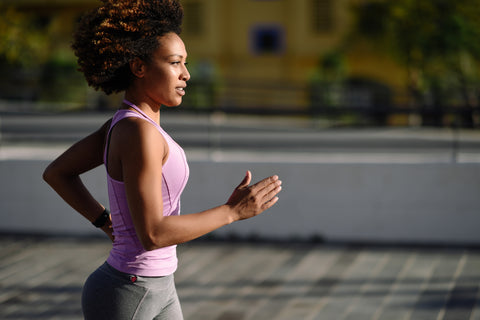
Running is one of the most universal sports out there. With the right pair of shoes, a running path, trail, track or treadmill and some grit, you’ve got what it takes to call yourself a runner.
While running is highly accessible, pounding the pavement (or treadmill) can take a toll on the body and cause common running injuries, like runner’s knee and hip, IT band pain, calf pain, shin splints, and lower back pain. Strengthening, stretching and maintaining proper form is crucial to success and avoiding common running injuries. Here, we share the best running tips for beginners and seasoned athletes alike from running pros and coaches.
‘Prehab’ to Ward Off Calf Pain After Running

One of the best running tips for dealing with common running injuries is to prevent them from happening in the first place.
Olympic silver medalist Meb Keflezighi, who has won both the Boston and New York City marathons, shared one of the most essential running tips in a recent Instagram post. “I’ve always ‘Prehab not Rehab.’ Injury prevention is proactive, not reactive.”
In his post, Keflezighi added running miles makes your aerobic system strong, but “they can break down your muscles if you don’t keep them strong and balanced with some strength work every week.” Find him on Instagram at @runmeb. Exercises like leg curls and calf raises work the calf muscles, which need to be strong to provide the basic support the rest of the body needs to run efficiently. Add some “prehab” strengthening workouts to your routine to avoid common running injuries like calf pain after running and to run more efficiently.
Maintain Proper Form to Combat Runner’s Knee

Runner’s knee is one of the most common running injuries. Known formally as patellofemoral pain syndrome, it results in pain right behind the knee cap. Runner’s knee is often caused by poor running mechanics: Think shuffling as you get tired or knees rotating inward due to weak hips and quads.
While strengthening the muscles around the knees is the long-term solution to preventing common running injuries like runner’s knee, one of the best running tips you can follow each run is to work on your form. Proper form will help you run more efficiently, even when you get fatigued.
Knee-wise, make sure it’s in line with the middle of your foot so when you strike the ground, the foot is right under the knee so you don’t waste energy on the knee drive. Runner’s World shares more running tips to maintain proper running form.
Run Smarter to Minimize Lower Back Pain After Running

Proper running form helps you run smarter, not harder. Not only will it help ward off common running injuries like runner’s knee, but will also minimize lower back pain after running. When you’re paying attention to your form, you’re less likely to force your back to pick up the slack of muscles that aren’t operating efficiently, like your core, glutes and hamstrings. (But don’t forget: The key way to prevent common running injuries is to routinely strengthen these important muscles!)
Running program RunRx shared key running tips to focus on your mechanics in a recent Instagram post (find them at @runrx). One way is to notice whether your foot is reaching ahead of you when you strike the ground: “Landing ahead of body adds up to 3X bodyweight and delays recovery to running pose. Your legs will usually let you know you are reaching with either early fatigue, pain/discomfort or an injury.”
Landing ahead may pull on the lower back, so focus on pulling your foot up after you strike the ground instead of reaching.
Improve Mobility to Avoid Hip Soreness After Running

Another one of the most common running injuries to plague runners is hip soreness after running. Again, weak muscles are the likely culprit behind hip pain after running, so incorporating regular “prehab” and strength training is key to strengthening the hips to improve form and efficiency.
Limited mobility may also contribute to hip soreness after running. This problem has become even more apparent as people shifted to working from home in 2020, often with little ergonomic support and, for some, less daily activity without commutes or colleagues to visit.
Running coach Mary Johnson wrote in an Instagram post, “One of the biggest things I've seen pop up during Quarantine are a series of hip issues - from tight hip flexors to glute and piriformis nags that just won't go away. These new WFH work spaces (and, for many, we’re walking way less) are putting us in weird positions. And with the increased stress of...life: we're all feeling a bit rickity.”
She shares guidance for improving hip mobility over at @itsamarython on Instagram.
With These Runnings Tips in Mind, Get Moving

Running is simple, but it does take some getting used to in order to do it well and avoid common running injuries. Remember to strength train, pay attention to your form, run smart and work on mobility in between runs. Apply these running tips to your routine to help prevent common running injuries and enjoy the run.



Share:
Physical Therapy for Pain Management
Runnings Tips For Post-Race Recovery